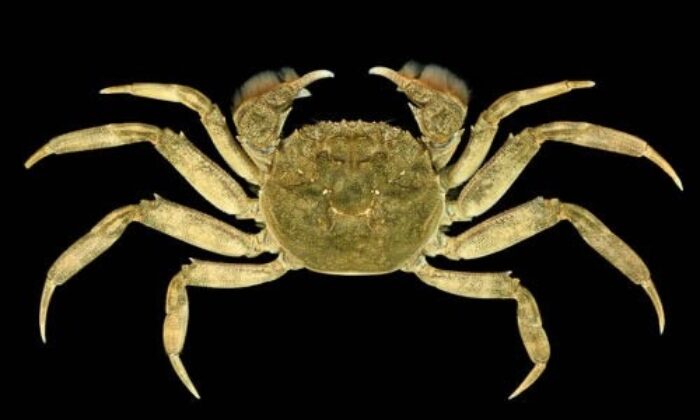The Chinese mitten crab (Eriocheir sinensis) is a fascinating creature that has intrigued biologists and invasived species experts alike. With its furry mitten-like claws and incredible migratory abilities, this crab species has captured attention around the world. But where exactly did these remarkable crabs come from in the first place? In this article we will dive into the mysterious origins of the Chinese mitten crab.
A Crustacean Native to East Asia
According to scientific research, the Chinese mitten crab is native to coastal regions of East Asia. Their natural range stretches from as far north as Korea down to the Fujian province in southern China. Throughout this range, the crabs inhabit rivers, estuaries, and other brackish coastal ecosystems.
Specifically, we know the crab originates somewhere between Hong Kong and the Korean border. The Yangtze River, which flows through central China, represents the core part of the mitten crab’s native territory. In fact, these crabs have been recorded migrating over 700 miles up the Yangtze from the coast!
Beyond this river basin, Chinese mitten crabs also reside in rice paddies and inland rivers near the sea across their native range. They thrive in the temperate subtropical climates of East Asia.
How Do We Know This Species is From Asia?
Researchers have been able to pinpoint the Chinese mitten crab’s origins in East Asia through several key sources of evidence:
-
Historical Records There are records of Chinese mitten crabs inhabiting their native range that date back centuries References to the crab can be found in ancient Chinese texts and art
-
Indigenous Names: The Chinese mitten crab’s common names in Asian languages also provide clues about its origins. For example, in Mandarin the crab is called “big sluice crab” and in Shanghainese it is known as the “big floodgate crab”.
-
Migration Patterns: The amazing migration of Chinese mitten crabs from rivers to oceans and back again also suggests these behaviors evolved in Asian ecosystems.
-
Genetics: DNA studies show the Chinese mitten crab shares recent common ancestry with other crab species endemic to East Asia.
-
Lack of Records Elsewhere: There is no evidence of stable populations of this crab species anywhere outside of Asia prior to human introduction.
When Did Mitten Crabs Arrive in North America and Europe?
Chinese mitten crabs are considered an invasive species outside of Asia. Thanks to human activities, this crab has successfully colonized ecosystems in Europe and North America. But when exactly did they arrive on each continent?
-
Europe – The first recorded arrival of Chinese mitten crabs in Europe dates back to the early 1900s. Germany reported populations in 1912, having likely migrated from Asia via ballast water discharge from commercial ships.
-
North America – Sightings in North America are much more recent. Mitten crabs were first spotted in the Great Lakes in the 1960s-1980s but did not establish permanent populations. The Chesapeake Bay and San Francisco Bay saw introductions in the 1990s-2000s that have persisted.
In both cases, it appears human transport enabled the Chinese mitten crab to expand its range dramatically from its original domain in Asia.
The Crucial Role of Life History in Invasive Success
A key factor that has allowed Chinese mitten crabs to succeed as invasive species is their unique life history. This unusual lifestyle evolved in Asia, but also primes them for rapid growth in new environments:
-
They spend most of their lives in freshwater rivers and lakes.
-
Upon reaching maturity after 4-5 years, they migrate downstream to marine estuaries to breed.
-
Females return upstream to release their larvae, which gradually make their way back into freshwater habitats.
This migration between saltwater and freshwater allows mitten crab populations to disperse upstream into inland waterways. Their larvae can also be easily transported in ballast water of ships, spreading them transcontinentally.
While Chinese mitten crabs now reside on three continents, research consistently indicates this species arose in East Asia. Northern China and the Yangtze River represent the heart of their native range. Records, names, genetics, and life history all provide clues that point back to coastal China as the original home of these crabs. Hopefully this article has shed some light on the long history and invasion ecology of the captivating Chinese mitten crab!

Where it has been found
It was seen for the first time in the Great Lakes in 1965, most often in Lakes Ontario and Erie. It appeared in the St. Lawrence River in 2004. No freshwater crab species existed in North America before its arrival. The Chinese Mitten Crab was first found in 1992 on the west coast of California. This means that they might be able to spread to B C. waters via coastal commercial shipping activities.
You can find the Chinese Mitten Crab in estuaries, lakes, rivers, and wetlands with fresh or salt water up to ten meters deep. It can live in a lot of different temperatures and levels of saltiness, and it doesn’t mind being in dirty or disturbed places. It is a catadromous species that lives in freshwater and reproduces in saltwater.
Search Search Fisheries and Oceans Canada
If you think you have found an aquatic invasive species:
- take photos
- note:
- the exact location (GPS coordinates)
- the observation date
- identifying features
- Adult size: 3 to 10 cm;
- Colour: greenish brown;
- Shell with four spines on each side and a cut between the eyes;
- It has two claws that are the same size and have white tips and thick, fluffy hair. The adults look like they are wearing mittens.
- Legs twice as long as the carapace width.
No native species have hairy claws.
